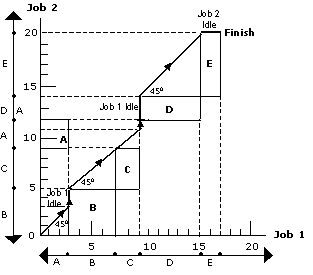Processing 2 Jobs Through m Machines
This section focuses on the sequencing problem of processing two jobs through m machines. Problems under this category can be solved with the help of graphical method. The graphical method below is explained with the help of the following example.
 Example
Example
Two jobs are to be performed on five machines A, B, C, D, and E. Processing times are given in the following table.
Job 1 |
Machine | ||||||
|---|---|---|---|---|---|---|---|
| Sequence | : | A | B | C | D | E | |
| Time | : | 3 | 4 | 2 | 6 | 2 | |
| Job 2 | Sequence | : | B | C | A | D | E |
| Time | : | 5 | 4 | 3 | 2 | 6 | |
Use graphical method to obtain the total minimum elapsed time.
Solution.
 Steps
Steps
- Mark the processing times of job 1 & job 2 on X-axis & Y-axis respectively.
- Draw the rectangular blocks by pairing the same machines as shown in the following figure.

- Starting from origin O, move through the 450 line until a point marked finish is obtained.
- The elapsed time can be calculated by adding the idle time for either
job to the processing time for that job. In this illustration, idle
time for job 1 is 5 (3+2) hours.
Elapsed time = Processing time of job 1 + Idle time of job 1
= (3 + 4 + 2 + 6 + 2) + 5 = 17 + 5 = 22 hours.
Likewise, idle time for job 2 is 2 hours.
Elapsed time = Processing time of job 2 + Idle time of job 2
= (5 + 4 + 3 + 2 + 6) + (2) = 20 + 2 = 22 hours.



